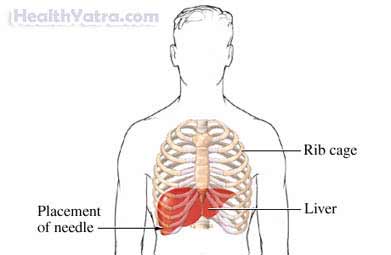Definition
This is a procedure to obtain a sample of your liver tissue.
Reasons for Procedure
Biopsies of the liver are usually done to evaluate:
- Abnormal blood tests (eg, elevated liver enzymes, elevated copper, or iron in the blood)
- An enlarged liver
- The severity of liver diseases
- The progress of therapy for liver diseases
- A liver mass
- The liver after a liver transplant
Possible Complications
If you are planning to have a liver biopsy, your doctor will review a list of possible complications, which may include:
- Pain (common)
- Bleeding (uncommon)
- Infection (rare)
- Perforation of the gallbladder or intestines (rare)
- Puncture of the lung (rare)
Factors that may increase the risk of complications include:
- Smoking
What to Expect
Prior to Procedure
Your doctor may do the following:
- Physical exam
- Blood tests
- Ultrasound—a test that uses sound waves to examine the liver
Before your biopsy:
- Avoid eating or drinking for 8-12 hours.
- Talk to your doctor about your medicines. You may be asked to stop taking some medicines up to one week before the procedure, like:
- Anti-inflammatory drugs (eg, aspirin )
- Blood thinners, such as clopidogrel (Plavix) or warfarin (Coumadin)
- Arrange for someone to drive you home after the biopsy.
Anesthesia
Local anesthesia—just the area that is being operated on is numbed; given as an injection and may also be given with a sedative
Description of the Procedure
There are different techniques to do a liver biopsy, including:
- Conventional liver biopsy
- Laparoscopic liver biopsy (done when the biopsy needs to be taken from a very specific area of the liver)
- Transvenous liver biopsy (done if your blood clots poorly or you have a lot of fluid in your abdomen)
Conventional Liver Biopsy
You will lie on your back with your right hand behind your head. The doctor might use an ultrasound or CT scan to help guide the placement of the needle. The skin will be cleaned. Next, the doctor will inject medicine to numb the area. The doctor will make a small incision. You will need to exhale and hold your breath while the needle is inserted. Sometimes, the needle will need to be inserted several times. After the procedure, your doctor will bandage the area. You will lie on your right side for at least two hours.

Laparoscopic Liver Biopsy
Your doctor will make a tiny incision. She will pass a long tool with a camera on the end into your abdomen in the area of the liver. The scope will send images of the liver to a TV screen. Your doctor will make other incisions to pass other tools. With these tools, she will remove samples of the liver.
Transvenous Liver Biopsy
Your doctor will thread a tiny flexible tube into a vein in your neck or groin. This tube will be threaded all the way into the veins in your liver. Your doctor will pass a biopsy needle through the tube to get a biopsy sample.
Immediately After Procedure
You will lie on your right side for at least two hours.
How Long Will It Take?
About 15-20 minutes
Will It Hurt?
You will have mild pain or cramping at the biopsy site. You may also have pain in the right shoulder. The pain should last for less than 30 minutes.
Postoperative Care
When you return home after the procedure, do the following to help ensure a smooth recovery:
- If a sedative was given, do not drive for at least 24 hours.
- Rest the remainder of the day.
- Do not exercise or lift heavy objects for at least a week. Ask your doctor when you can resume normal activities.
- Eat your normal diet.
- Ask your doctor when you can resume taking your medicines.
- Ask your doctor about when it is safe to shower, bathe, or soak in water.
- Be sure to follow your doctor’s instructions .
The results will take 1-4 weeks. You and your doctor will discuss the results.
Call Your Doctor
After arriving home, contact your doctor if any of the following occurs:
- Signs of infection, including fever and chills
- Redness, swelling, increasing pain, excessive bleeding, or any discharge from the incision site
- Severe abdominal pain, nausea, or vomiting
- A faint or light-headed feeling
- Severe shoulder pain
- Trouble breathing, cough, or chest pain
In case of an emergency, call for medical help right away.
